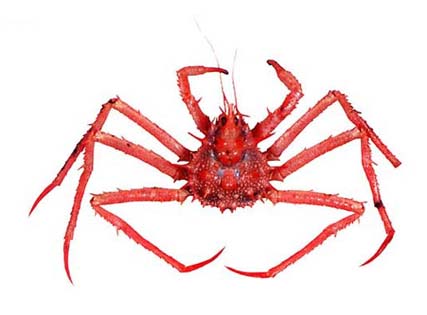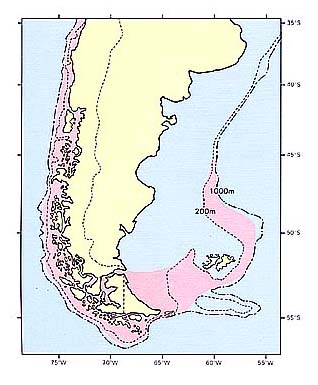タラバガニ科
- HOME
- デジタル図鑑
- パタゴニア海域の重要水族
- 節足動物門 甲殻綱 十脚目
- タラバガニ科
タラバガニ科(Lithodidae)

138 テシオイバラガニ(Teshio-ibaragani)
Lithodes murrayi Henderson, 1888
Centolla (Ch.)
特 徴:
甲幅20cmに達する大形種。甲の輪郭は洋梨形で,粟粒状の大小の顆粒でおおわれるほか,長いとげが左右相称に配列している。ただし,大形個体ではとげが短くなり,単なる突起になる。胃域は細長く,盛り上がり,2対のとげがあるが,前方の1対がやや長い。心域は小さいが明瞭で,1対のとげが左右に並び,それぞれ弱く外方を向く。肝域縁には斜め外上方を向く長いとげがある。鰓域上には中央部に2本のとげが縦に並び,また,外縁に沿って7,8本のとげが並ぶが,側縁中央部の2本が長い。肝域縁と鰓域縁前部は弱い稜をなし,ごく浅いへこみで分けられる。額角は小形個体では長く,先端が大きく二叉し,また背縁の中央部には1対のとげがある。はさみ脚,歩脚とも鋭い大小のとげ状突起でおおわれているが,いずれも歩脚の先方を向くため,一見鱗状を呈する。はさみ脚の長節と腕節には長いとげがある。また,歩脚の長節前縁(1本は末端)の4,5本,腕節上面の基部と先端の1本ずつのとげが他のものより長い。歩脚は細長く,指節は前節の2/3ほどの長さである。
分 布:
アルゼンチン沖海域新記録。従来の記録はインド洋西南部のプリンスエドワード諸島沖およびクロゼ諸島沖,南アフリカ東岸沖,ニュージーランド南島南端のフォーボー海峡,さらに南方のマックオリー島沖,チリのバルパライソより南部の水深75〜700m。
備 考:
甲長20cmを超える成体の大きさに比較すれば,採集された2個体は小形で,額角および肝域,鰓域縁のとげが長いのもそのためである。クロゼ諸島沖での試験操業の結果がArnaud et al.(1976)およびArnaud and Do-Chi(1977)により報告され,成長や食性,垂直分布,移動などとともに商業漁獲の可能性が指摘されている。
文 献:
Henderson (1888); Hale (1941); Yaldwyn and Dawson (1969); Arnaud (1971); Kensley (1977).
(武田正倫)
Material examined:
FSFL EL788 (1♂-48°58′S, 59°W, 554 m deep; May 2, 1978); EM531 (1♂-46°03′S, 60°01′W, 581 m deep; May 26, 1978). Breadth of carapace excluding lateral spines, about 5 and 6 cm in two specimens.
Description:
A large species. Carapace pyriform, densely covered with minute granules, and armed with long spines in smaller individuals and with tubercles in larger ones; gastric region longitudinal and convex, being armed with 2 pairs of spines; cardiac region small, but distinct, and armed with a pair of spines side by side; hepatic margin with a spine; branchial region with 2 longitudinally disposed spines on its median part and with several spines along outer margin; hepatic margin and anterior part of branchial margin weakly ridged, being separated by a wide, shallow depression. Rostrum very long in small individuals, with deeply bifurcated tip, having a pair of long spines at median part. Chelipeds and ambulatory legs armed with spiniform tubercles of various length, which are directed distally and thus more or less of scaly appearance. Merus and carpus of cheliped with long spines, and some spines on each anterior margin of ambulatory meri and 2 spines at upper basal and distal parts of each carpus are longer than the others; ambulatory legs slender, with dactyli about two-thirds as long as propodi; upper surface of each dactylus with a longitudinal furrow on its proximal third, being armed with a depressed tubercle at proximal part of its lateral margin.
Distribution:
Previously known from off the Prince Edward and Croze Islands in the southern Indian Ocean, off east coast of South Africa, southern New Zealand, Macquarie Island and off Chilean coast; 75-700 m deep.
Remarks:
Two specimens at hand are rather small and probably not fully matured. Spines on the carapace and ambulatoly legs are markedly longer than those of the larger individuals. This species is widely distributed in Subantarctic waters, but new to the Southwest Atlantic.
(Masatsune TAKEDA)

Distribution of Lithodes murrayi in Patagonia.